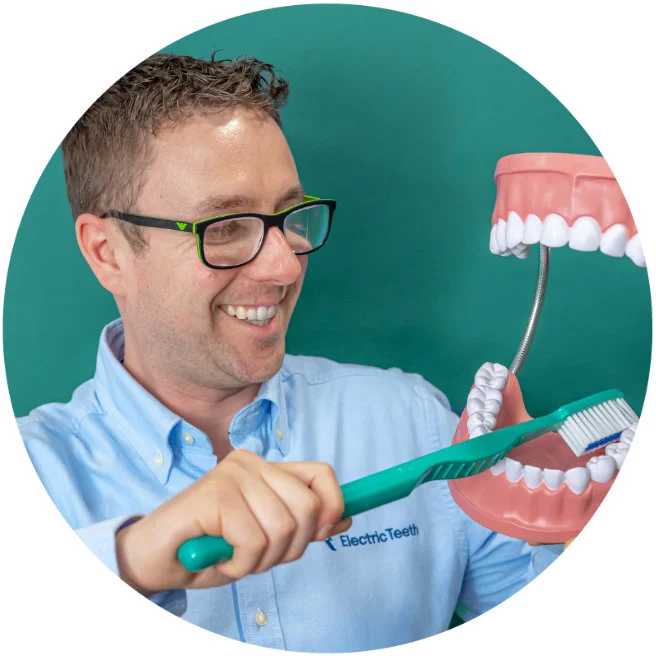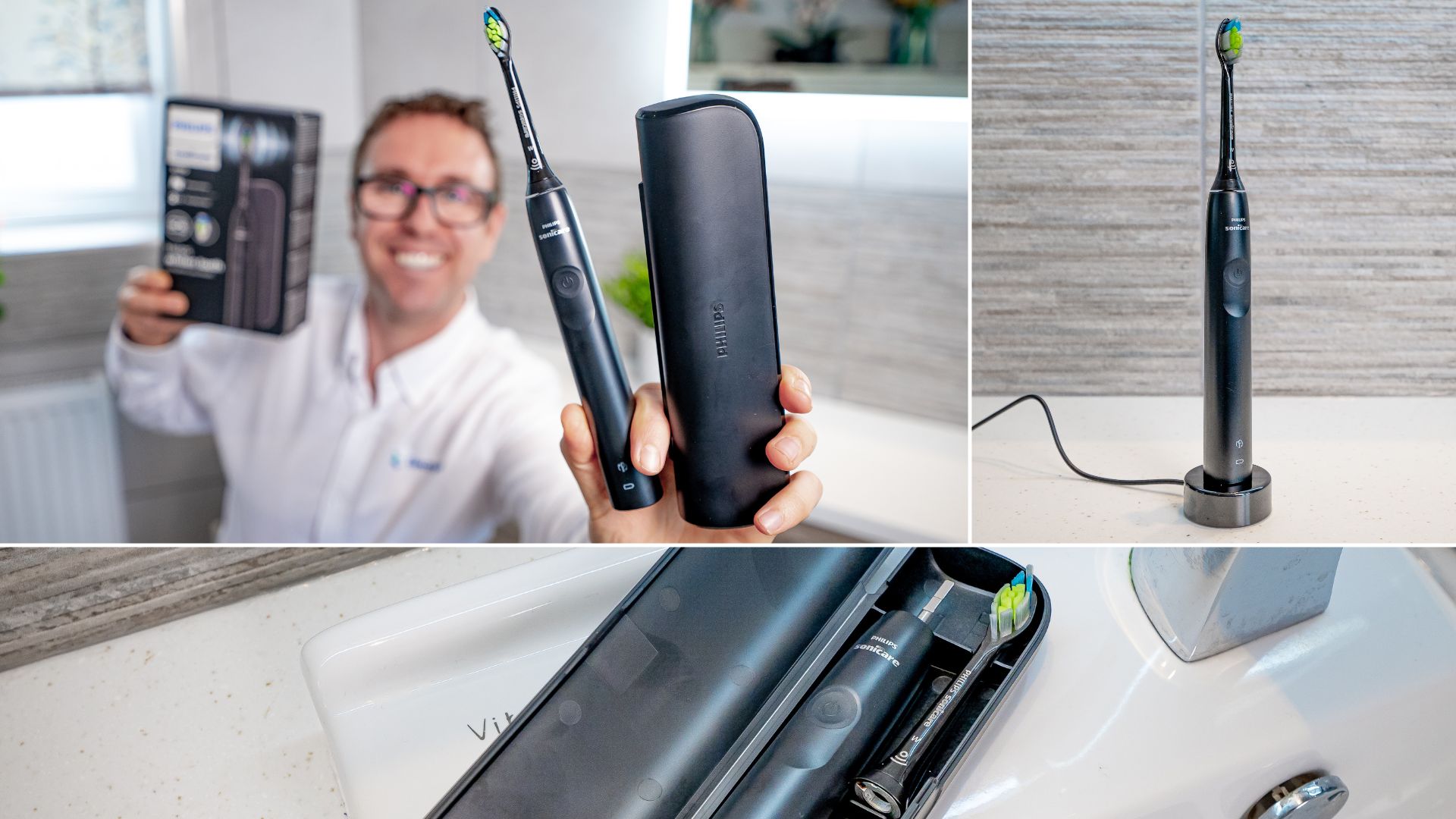
A solid all-round performer – a top pick at the right price
We like the 4100 Series a lot. It has the essential features required, as well as some extras.
It would be our top pick if it weren't for the more affordable 3100 Series.
At £50-65 the 4100 is a must buy.

Pros |
Cons |
|---|---|

Slim, stylish & easy to keep clean |
No indicator lights to show which mode is selected |

2 cleaning modes – choose between clean & sensitive |
Sonic motor configured differently to premium models |

USB charging stand makes it more convenient for some |
USB charger makes it less convenient for some |

Reminds you when to replace your brush head |
A more affordable choice
The 3100 Series is very similar to the 4100, but often quite a bit cheaper.
You get 1 cleaning mode rather than 2 and the 3100's motor is tuned differently. The cleaning results are pretty much identical. You just don't get quite the same deep clean feeling.
The 3100 delivers great performance for the price and is our most recommended Sonicare toothbrush.

A slim and minimal toothbrush that is easy to keep clean
First impressions of the 4100 Series are great. It’s lighter and slimmer than its predecessor, which impacts battery life, but thankfully not too much.
Durable and quality feeling in the hand
It isn’t the most grippy of toothbrushes I have used. There is a lack of raised notches and rubber panels compared to others. Yet the matt finish somehow gives a reassuring resistance against the palm and fingertips. The squarer edges to the handle - which isn’t a perfect cylinder - help too.
The minimal design and lack of textured surfaces make it easier to keep clean.
It looks good and feels quality in the hand. Squeezing the handle doesn’t result in any dubious sounding creaks or groans from the plastic.
It’s water resistant too, use it in the shower or rinse it under the tap.
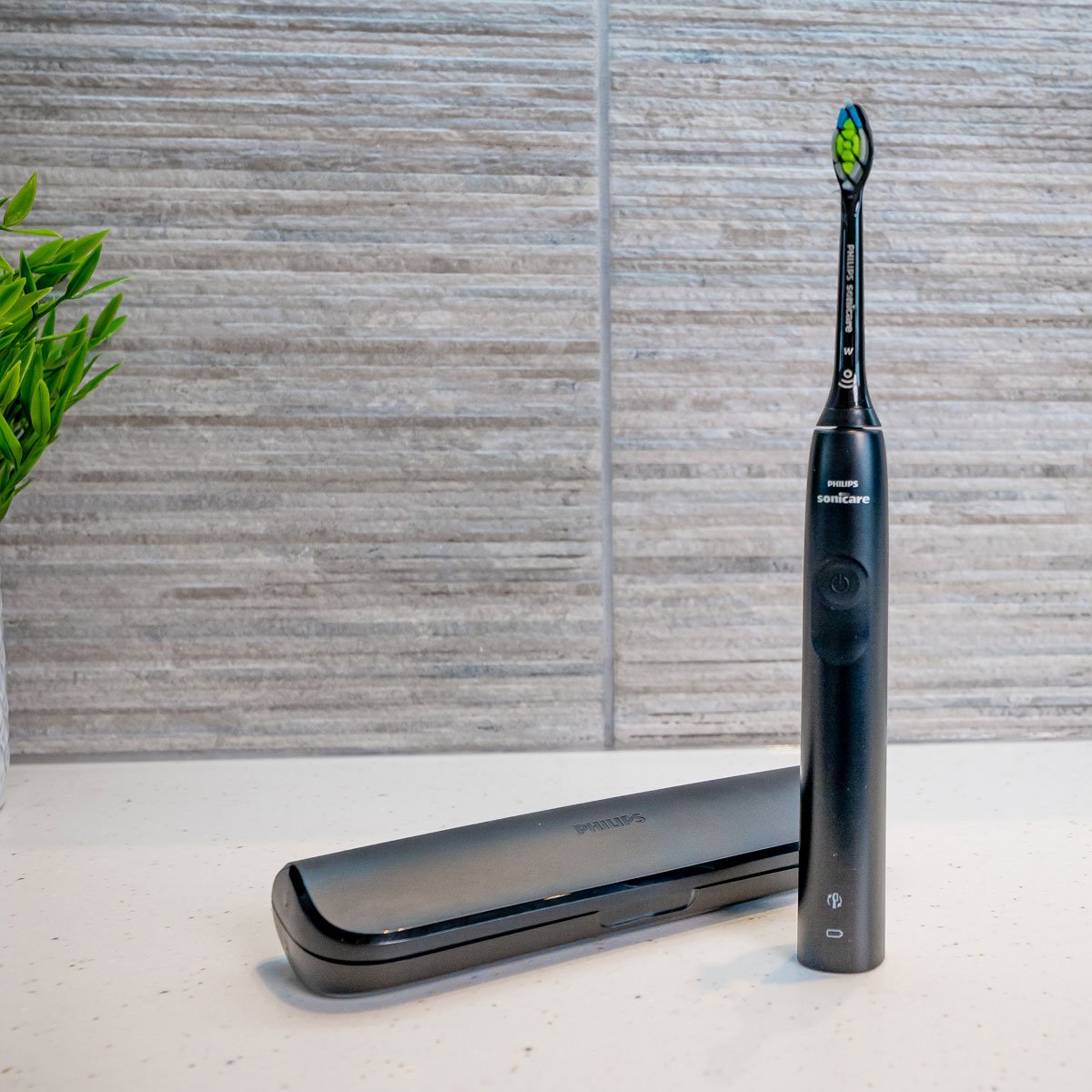
The power button gives a nice clicky feedback
The only button on the handle has a concave shape, with a rubber finish and power icon embossed. It’s easily detected by the fingertip and when pressed gives reassuring feedback whilst producing a clicky sound.
It isn’t very firm, great for those with limited dexterity.
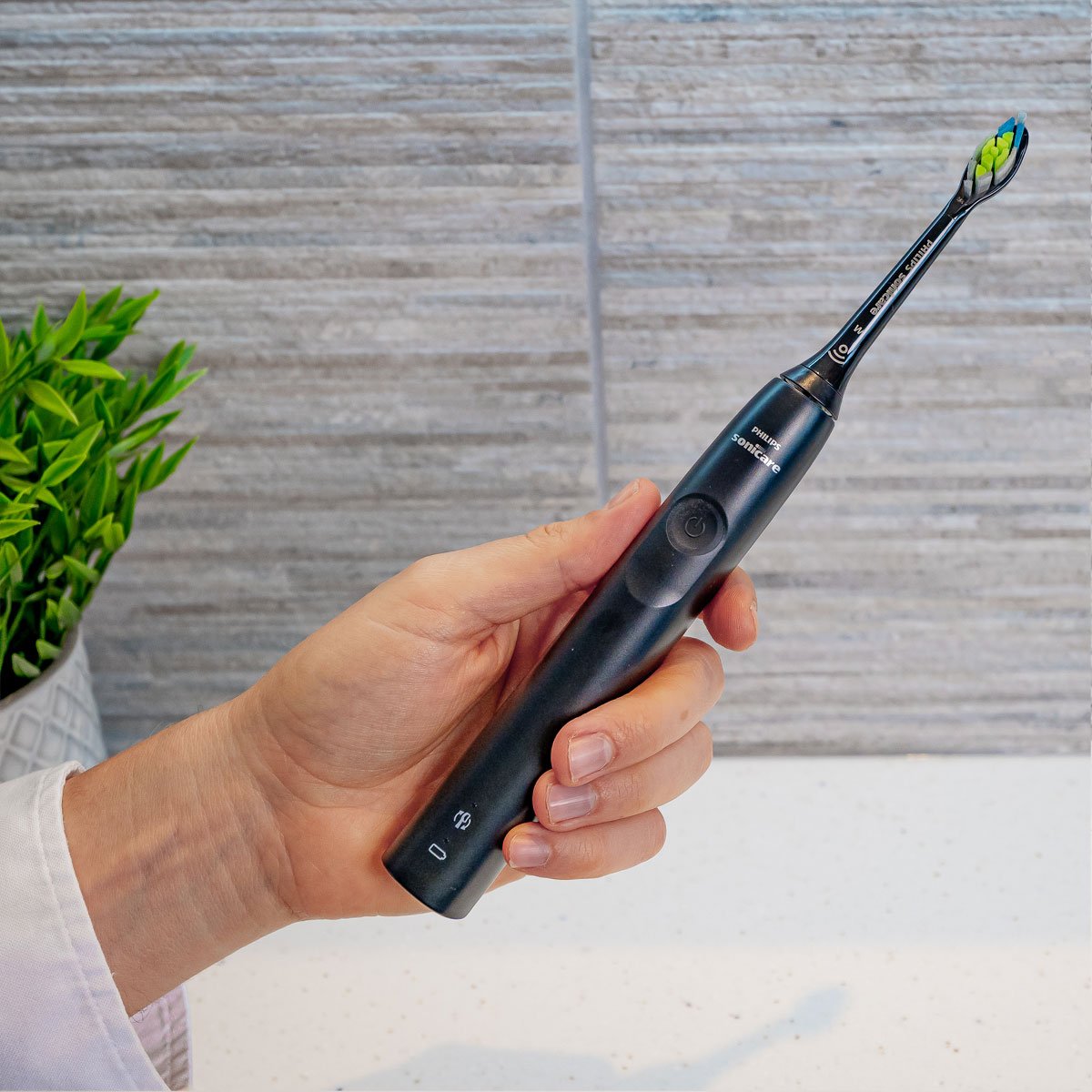
The optional travel case provides protection when on the go
The 4100 Series is available with or without a travel case in either black or white colour options.
My pick is the variant with the case, assuming it’s no more than £10 more expensive. It’s incredibly useful for those nights away from home.
Holding the handle and up to 2 heads, it’s basic but functional.
The variants and their model numbers are:
- 4100 with no travel case
- White - HX2681/33
- Black - HX3681/54
- 4100 with travel case
- White - HX3683/33
- Black - HX3683/54
Cleaning results that make you smile
Plaque disclosing tests confirm that the 4100 does a very good job of cleaning your teeth. I get that deep and invigorating clean feeling after each use. I certainly have no complaints.
You can switch between 2 brushing modes
Clean and Sensitive are the 2 cleaning modes available. Think of them like a high and low mode. There is a noticeable difference in the brushing intensity.
Clean is my preference and the mode I recommend you use daily.
The low mode is ideal for when your teeth and gums feel a bit tender or inflamed. It’s good for new toothbrush users too. But, the 4100 does have an EasyStart mode which gradually increases the brushing intensity over the 14 sessions to ease you in.
There are no labels or icons on the handle to confirm which is selected. You can tell the difference between them based on the sound and intensity.
There is no whitening or gum care mode. Additional cleaning modes and their benefits are often overrated, rarely do they bring significant benefits.
The motor’s configured differently, but it doesn’t impact results
It doesn’t achieve 62,000 movements like many of Sonicare’s premium brushes.
A slightly less powerful feeling might be noticed by existing Sonicare toothbrush users. But, even to me, this difference isn’t immediately obvious due to the way the motor has been tuned.
Power and the number of movements the bristles make are only part of the equation in achieving clean teeth. So the fact that the motor in the 4100 is programmed slightly differently isn’t a massive issue.
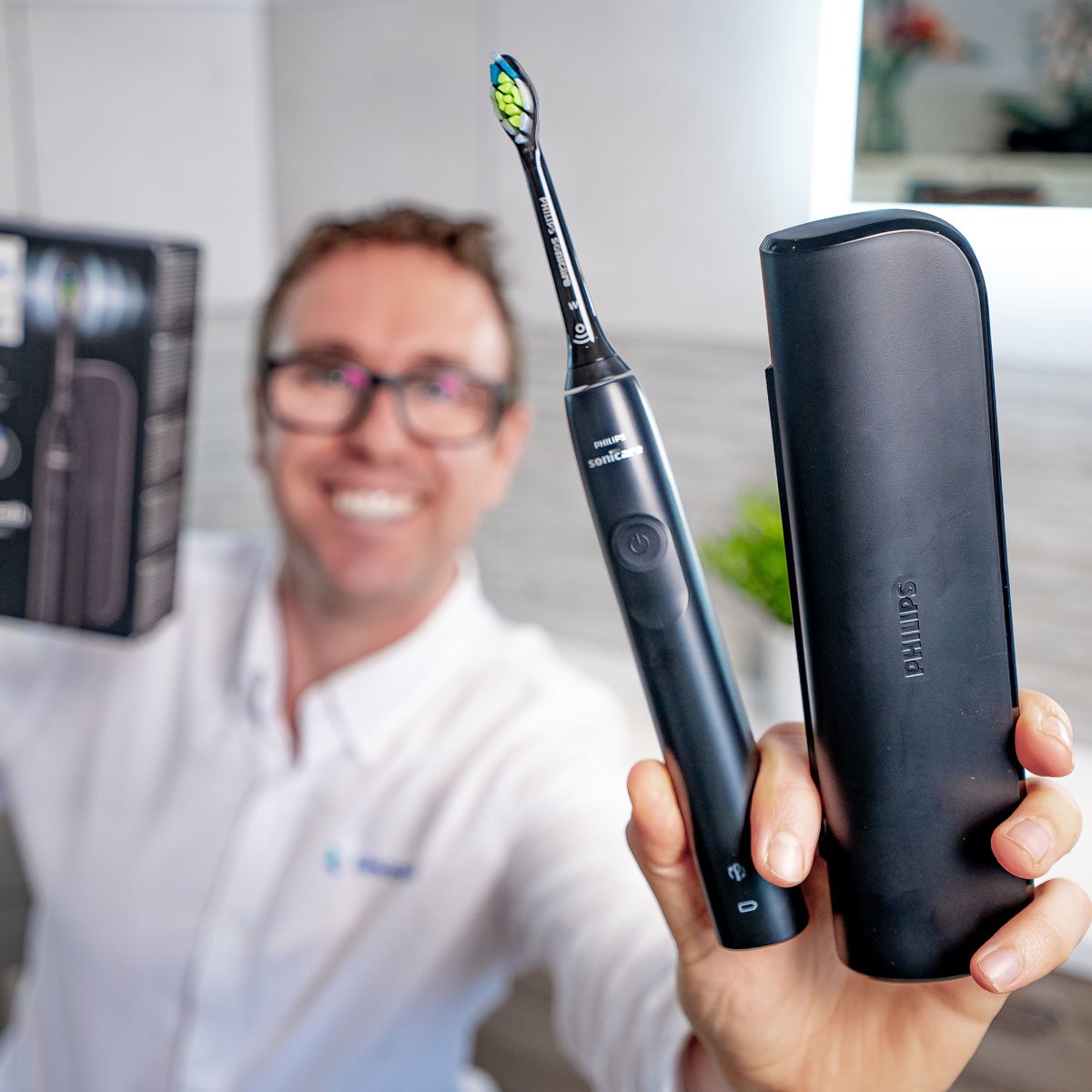
It might be worth switching the brush head supplied
Philips offers a diverse range of interchangeable brush heads that are compatible with the 4100 Series.
A single W2 Optimal White brush head is provided with the 4100. It achieves a good overall clean. It is perfectly usable but is designed to maximise stain removal, to make the teeth appear whiter. We prefer the soft G2 Optimal Gum Care or C2 Optimal Plaque Control heads for everyday cleaning.
The push-on and pull-off heads make it simple to switch between styles if you so desire. Premium, silicone backed alternatives of these heads exist, but they don’t provide any significant benefit.
We might have slight preferences, but none are going to provide dramatic differences in the cleaning results. Worry more about your technique and brushing time than brush head style.
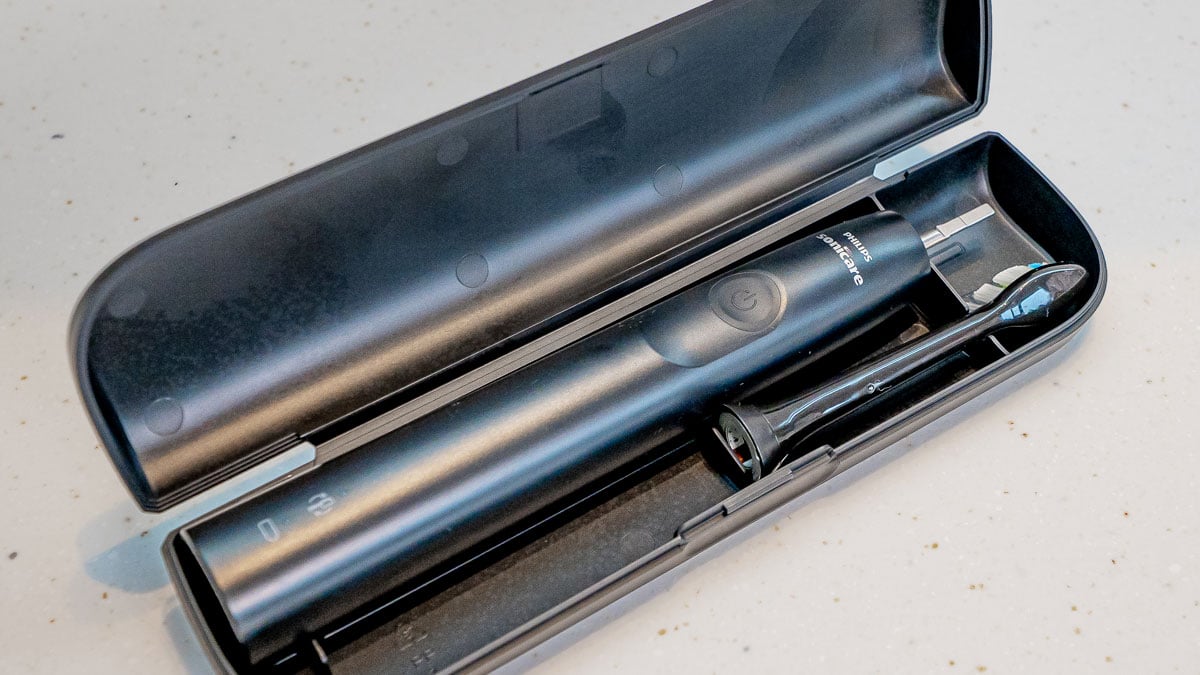
Only must-have features are included, not lots of unnecessary extras
The 4100 comes with the essential, dentist recommended features you need. Extras might enhance daily user experience but often bring limited benefits.
The timer and pacer help you to brush for the right amount of time
Most dental professionals, our in-house dentists included, recommend cleaning the teeth twice a day, for at least 2 minutes each time. Yet, statistics show many people brush for just 45-70 seconds in total.
Let’s be honest, there are more fun things to do than brushing your teeth.
The 4100 Series helps you achieve this though. The timer kicks in as soon as you press the power button. It then turns the brush off automatically after a 2 minute brushing session. So, if you turn the brush off, you know you haven’t brushed for long enough.
To keep your teeth healthy you need to try at least to give them all equal attention. The QuadPacer or 30 second timer pauses the bristle motion. It creates a change in sound and brushing sensation. This is your cue to move between the 4 sections of the mouth until all have been brushed.
Watch this video to learn more about quadpacers and how they work.
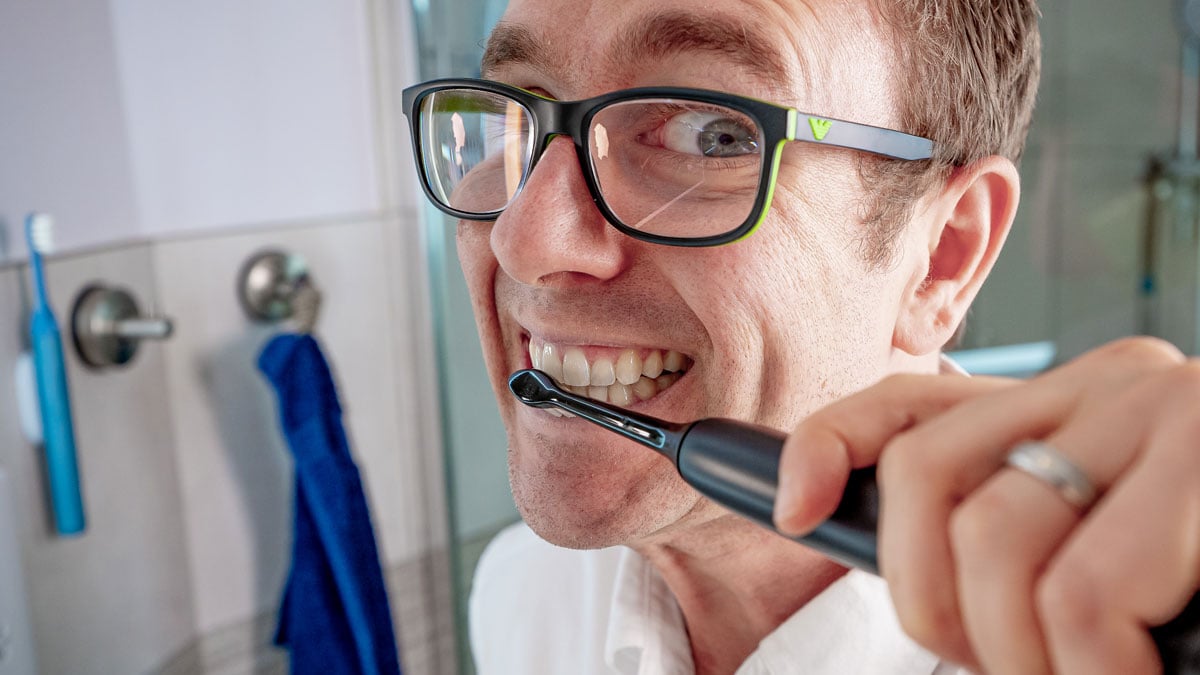
The pressure sensor alerts you when you brush too hard
Too much pressure can cause wear on the teeth and gums and in the long term result in irreversible damage. The 4100’s built-in pressure sensor can help you if you know you brush too hard.
The handle vibration pattern changes whilst it detects too much force is being applied. At the same time, the brushing sensation and sound alter.
Where you get a large visible light on many Oral-B brushes, you don’t on the 4100. Technically the BrushSync replacement reminder LED also flashes amber. Given its position and size, it is not the easiest to see.
Don’t worry if you end up activating the pressure sensor occasionally, I still do. You just want to correct frequent forceful brushing.
Reminds you when your brush head needs replacing
The provided W2 head, along with the majority of other bristle options now have a Radio Frequency Identification Chip (RFID) built-in.
Communicating with the 4100 handle, the usage time of the head is tracked. After the equivalent of 3 months use, a light is lit on the handle and a vibration is emitted to alert you that it’s time to change the head.

Continuing to use it for a bit longer isn’t a massive issue, but it could be cleaning less effectively and the tips will likely have become worn and could be more abrasive on the surfaces in the mouth.
If you’re not too hot on remembering when you last replaced your head this can be a handy reminder.
This clever system is otherwise known as BrushSync technology. Our guide to BrushSync explains the things you need to know.
The battery gives a minimum of 2 weeks use
I achieved 17 days of use on the higher of the 2 brushing intensities but a staggering 41 days on the lower. So it is safe to say that the minimum you will achieve is the 2 weeks Philips claim.
This is more than acceptable from the rechargeable Lithium-Ion battery, but the industry average does tend to be around 3-4 weeks. So the 4100 perhaps falls marginally behind here. The benefit is the slimmer and lighter handle.
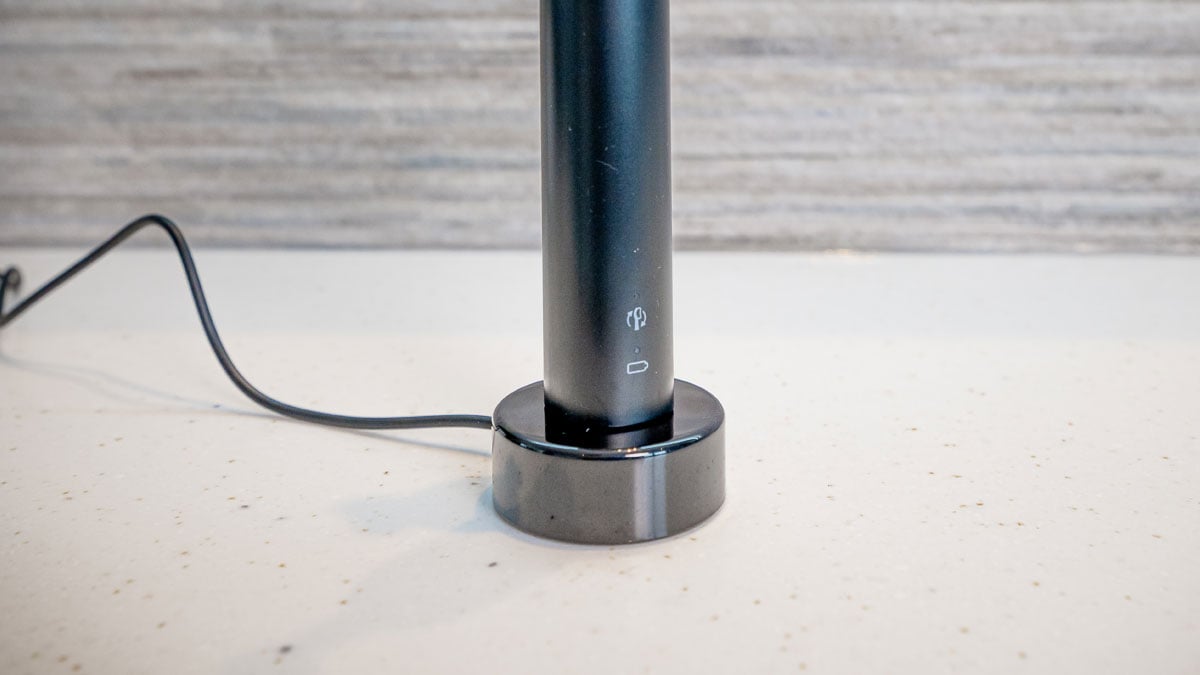
USB charging makes it more difficult for some
A new style of charging stand is included. Compared to previous stands with a 2 pin power adapter, this has a USB type A male connector. The cable is hardwired into it and measures 110cm (43 inches) long. The footprint of the stand is smaller too with a more rounded shape.
A protuberance on the top of the stand still exists. This fits into the base of the brush handle.
A full charge can take up to 24 hours. An LED on the handle gives feedback on the charge level when on and off the charger.
Environmental reasons mean that no 2 pin USB power adapter is provided. This is an inconvenience for many who want to charge from a bathroom shaver socket.
Unless you source an adapter (they are not readily available), you will have to charge it from another socket in your home. Most of us now have USB to 3 pin adapters that can be used. Your smartphone or other tech gadgets likely came with one. Or because it has a USB connector, you can take advantage of powering it from more sources such as a computer or portable battery bank.
USB connectivity arguably makes it more travel friendly though.
Fairly priced for the features
£99.99 is the retail price of the 4100 Series. Don't pay this. Discounts are available, albeit not all the time. You should be able to pay around £50-60 when it is. At this price, it's a great buy.
If you want the travel case, you’ll be looking at £55-65 compared to the £109.99 retail price.
Brush heads do negatively impact ownership costs. At around £7 each, The 4100 Series (without the case) will cost around £132 to own over 3 years.
Our top recommended electric brush, the Oral-B Pro 3 3500 works out about £54 cheaper (£78). This is because Oral-B heads are half the price of Sonicare bristles. But, they don’t have RFID chips in them.
The 3100 Series is more affordable option from Philips for little compromise.
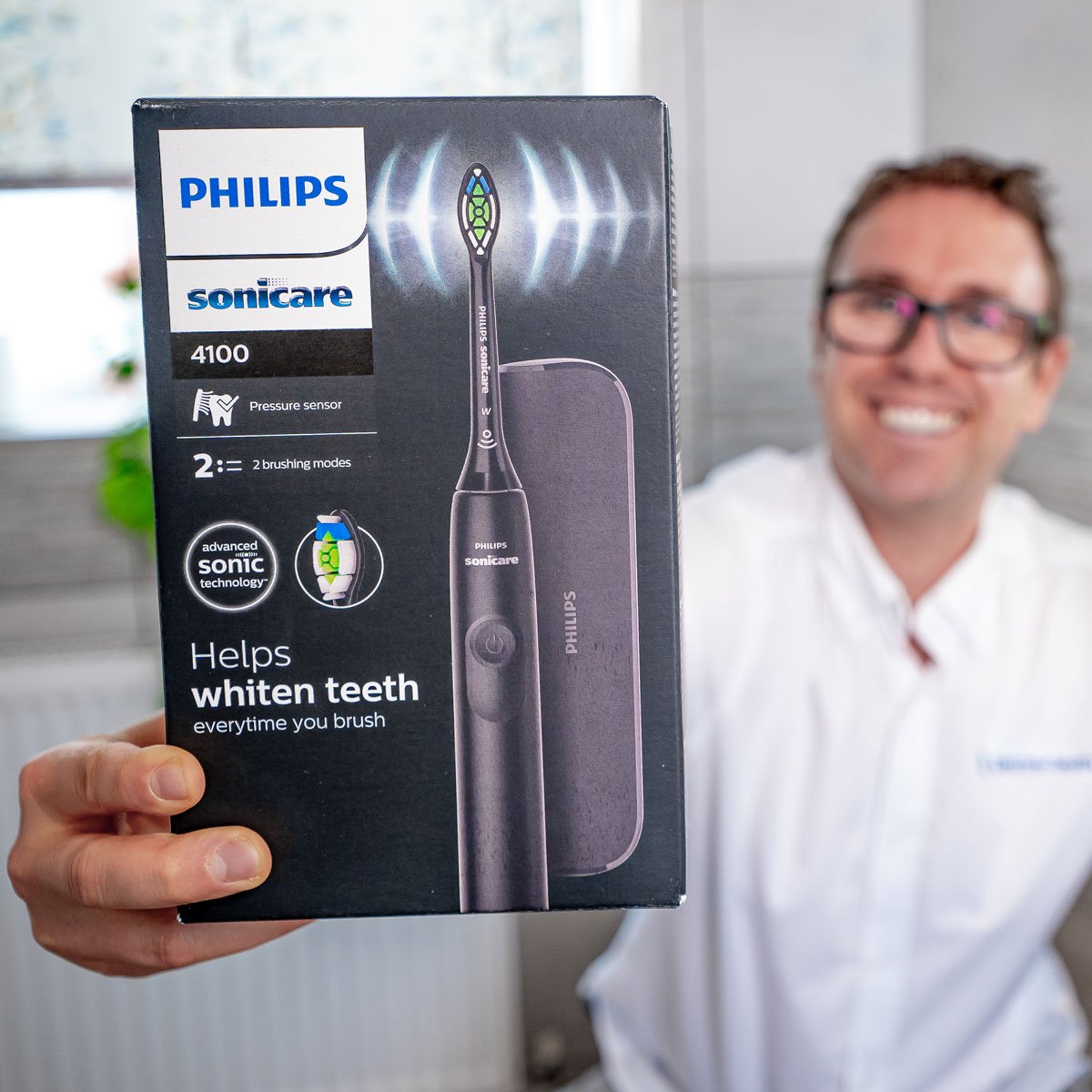
2 years support included as standard
An industry average 2 year warranty against defects and workmanship is provided. Unfortunately, no parts on the brush are designed to be user serviceable thus, should it fail, in most cases, they will send you a new brush.
With a need to move to more sustainable approaches the lack of repairability is disappointing.
By no means a defence, Philips has many years of experience behind them. The 4100 appears very well built and I’ve not found any cause for concern during my use.
Environmental impact
Philips exclude a 2 pin power adapter citing the environmental benefits. This is good, but feels somewhat silly when the handle and charging stand still come wrapped unnecessarily in plastic.
The paper based packaging is recyclable and the box is relatively small all things considered.
We don’t know the exact environmental impact of this particular model, but as a general rule electric toothbrushes have an impact 11 times greater than a manual brush on average.
RFID enabled brush heads do add to the impact but do potentially provide a benefit to some.
Not being a smart brush reduces the total number of components used and means not as much waste is created when the brush no longer works.
Petroleum based plastic is used in the construction of the brush which uses up the planet’s finite resources compared to using plant-based plastics.
It has not been designed to be easily repaired by yourself. Trying to replace parts like the battery will likely break the brush. This makes it more likely to be discarded rather than repaired if broken.
Philips has partnered with schemes such as TerraCycle in some countries, but doesn’t have its own scheme.
Conclusion: a brush you should buy if the price is right
Slim and stylish, equipped with the essential features recommended by dentists, and priced reasonably, there’s little to find fault with here.
The price is the only catch. It's not always on offer, but if you can buy at around £50-65, you won’t be disappointed.
Size guide
- Toothbrush height with head - 23.4cm / 9.2 inches
- Toothbrush height without head - 17.3cm / 6.8 inches
- Width - 2.5cm / 0.9 inches
- Depth/thickness - 2.7cm / 1 inches
- Weight with head - 97g / 3.4oz
- Weight without head - 92g / 3.2oz
- Travel case size - 19cm / 7.5 inches (L) x 5cm / 2 inches (W) x 3cm / 1.2 inches (D)
- Travel case weight - 49g / 1.7oz without brush or 146g / 5.2oz with brush
- Package weight - 388g / 13.7oz
Noise
- 60dB
Country of manufacture
- China
FAQ
How to turn on and off EasyStart
- Put the handle on the plugged-in charger.
- Press and hold the power on/off button while the handle remains on the charger.
- Keep the power on/off button pressed until you hear a single short beep (after 3 seconds).
- Release the power on/off button.
- Triple tone of low-med-high means the EasyStart feature has been activated. The battery level light indicator will also blink green 2 times to confirm activation.
- Triple tone of high-med-low means the EasyStart feature has been deactivated. The battery level light indicator will also blink amber 1 time to confirm deactivation.
How to turn on and off brush head reminder
- A smart brush head must be fitted to the handle to activate or deactivate.
- Put the handle on the plugged-in charger.
- Press and hold the power on/off button while the handle remains on the charger.
- Keep the power on/off button pressed until you hear a series of two short beeps (after 5 seconds).
- Release the power on/off button.
- Triple tone of low-med-high means the Brush head replacement reminder feature has been activated. The battery level light indicator will also blink green 2 times to confirm activation.
- Triple tone of high-med-low means the Brush head replacement reminder feature has been deactivated. The battery level light indicator will also blink amber 1 time to confirm deactivation.
How to turn on and off pressure sensor
- Put the handle on the plugged-in charger.
- Press and hold the power on/off button while the handle remains on the charger.
- Keep the power on/off button pressed until you hear a series of three short beeps (after 7 seconds).
- Release the power on/off button.
- Triple tone of low-med-high means the pressure sensor feature has been activated. The battery level light indicator will also blink green 2 times to confirm activation.
- Triple tone of high-med-low means the pressure sensor feature has been deactivated. The battery level light indicator will also blink amber 1 time to confirm deactivation.
- If you continue holding the power on/off button after the three short beeps, the activate/deactivate sequence repeats.



